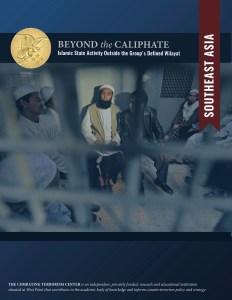
On 2 June, the Combating Terrorism Center published the second report in its Beyond the Caliphate series, which seeks to evaluate how the Islamic State’s influence, operational reach, and capabilities are changing in areas that fall outside of its physical caliphate. Focusing specifically on Southeast Asia, the report identifies trends in attacks, plots, and support activity (ending in arrest) linked to and inspired by the Islamic State in the region from June 2014 through April 2017.
The study found that the Islamic State is leveraging local militant groups to solidify and expand its presence in Southeast Asia. While the majority of Islamic State activity in Southeast Asia occurred in Malaysia and Indonesia, most attacks were conducted in the Philippines, specifically in regions where local militant groups have engaged in violent conflict with the state. The study also found that nearly half of all Islamic State-linked attacks and plots in the region had financial and/or communication ties to Southeast Asian Islamic State operatives in Syria where group members sought to enable and guide attacks remotely.
Both the first Beyond the Caliphate report (on Turkey) and the new report on Southeast Asia are available here.
 Skip to content
Skip to content
